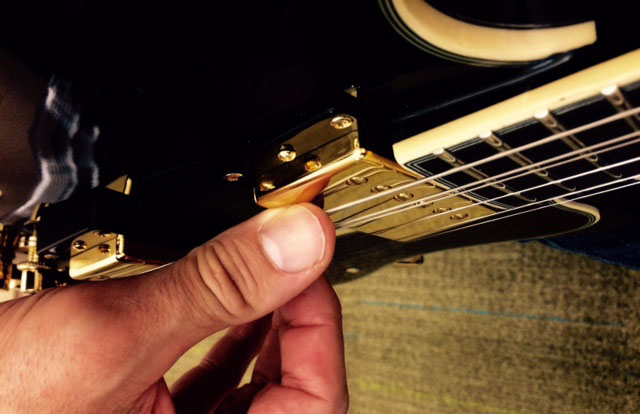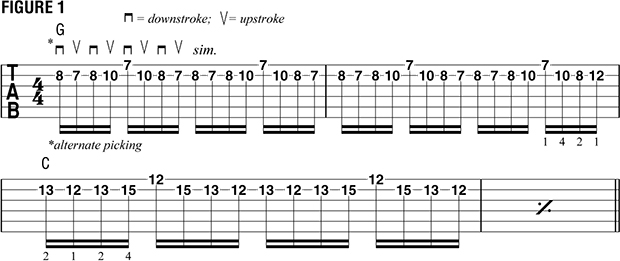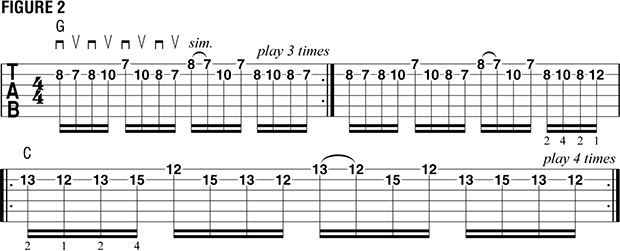Killer Runs to Sharpen Your Pick-Hand and Fret-Hand Skills
Fortify your fret-hand/pick-hand coordination while strengthening your overall chops and ability to play fast and clean.

In this column, I’d like to present a few single-note patterns that are designed to fortify fret-hand/pick-hand coordination while they strengthen your overall chops and ability to play fast and clean.
In my own experience, I have found that drilling on one or two very specific melodic fretboard shapes works wonders in uncovering technical areas of weakness in both hands.
Doing this over a long period of time will deliver solid results and make a marked improvement in your playing.
FIGURE 1 is a 16th-note run that begins with two bars of a melodic pattern based on the G major scale (G A B C D E F#), which I then transpose, in bars 3 and 4, up a fourth, to C major (C D E F G A B), via a quick position shift. For both of these shapes, I use my fret-hand’s first, second and fourth fingers (index, middle and pinkie) throughout.

Playing a shape like this over and over will uncover any shortcomings in your fret-hand dexterity. Be sure to fret using only your fingertips, with the thumb placed squarely on the back of the guitar neck in order for the fret-hand fingers to be positioned with a nice, high arch. Additionally, I use alternate (down-up) picking throughout and strive for absolute smoothness and even execution as the patterns are played over and over across the top two strings.
Now let’s add a slight twist to the melodic shape in order to work the fret hand a little more. In FIGURE 2, the melody played across beats one and two is identical to that of FIGURE 1, but I play different shapes across the last two beats of the bar, beginning with a pull-off on the high E string, followed by more alternate picking.

Here, the initial melodic shape is played four times in G before I transpose it up to C. Notice, however, that I do change the very end of the initial phrase, in bar 3, to accommodate the abrupt shift up to 12th position on the last 16th note.
In FIGURE 3, I use the previous melodic sequence as the basis for a new exercise run that ascends the fretboard through three different fingering patterns of the G major scale. Here, I play the patterns as 16th-note triplets, ascending and then descending on each successive eighth note.

Again, I rely on strict alternate picking and strive for absolute clean, even execution. As a whole, this pattern is much simpler than the previous ones, as it simply ascends and descends, but as you will find, getting it up to “shred speed” will require real work and diligence.
Get The Pick Newsletter
All the latest guitar news, interviews, lessons, reviews, deals and more, direct to your inbox!
“There are so many sounds to be discovered when you get away from using a pick”: Jared James Nichols shows you how to add “snap, crackle and pop” to your playing with banjo rolls and string snaps
Don't let chord inversions bamboozle you. It's simply the case of shuffling the notes around







![Joe Bonamassa [left] wears a deep blue suit and polka-dotted shirt and plays his green refin Strat; the late Irish blues legend Rory Gallagher [right] screams and inflicts some punishment on his heavily worn number one Stratocaster.](https://cdn.mos.cms.futurecdn.net/cw28h7UBcTVfTLs7p7eiLe.jpg)


